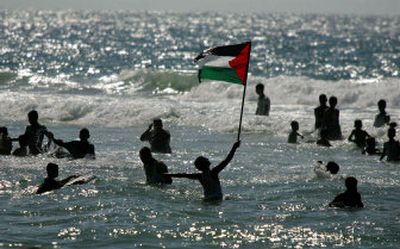Awash in freedom, Gaza rejoices

MOASSI, Gaza Strip – For 38 years, Palestinians were separated from this land, known to them as Moassi, and to the Israeli settlers who occupied it as Gush Katif.
Now Palestinians were back, streaming in by the tens of thousands, the name Moassi on their lips.
The settlers and troops who guarded them were finally gone.
The Palestinians came on foot. They came in cars. They came driving donkey carts that caused braying traffic jams.
They headed for the beach and a long awaited swim in the Mediterranean that for years they could see shimmering from the rooftops of nearby Khan Yunis, but could never reach because Israeli troops barred the way.
Some of the first to arrive before dawn set protest fires.
By midmorning Monday, heavily armed factions, including Hamas and Islamic Jihad, held impromptu parades. Masked men cruised in small convoys on flatbed trucks and occasionally ripped off celebratory gunfire against the background sounds of martial music blaring from truck-mounted speakers.
But mostly it was a day for ordinary Palestinians to revel in moving freely on formerly forbidden roads and to scavenge the rubble of razed settler houses for scraps of metal, plumbing parts, electrical panels and pieces of tile they could use or sell.
Payback?
More like payday. Or so it seemed to one scrap-metal dealer, who paid from $100 to $1,000 a ton for raw iron and aluminum and estimated his business, up 30 percent, would stay that way for a few more days.
In an ironic twist that showed how inextricably the Palestinian and Israeli economies are intertwined even after disengagement, dealer Ibrahim Baraka said the metal brought to him at his factory yard in Deir el-Balah would eventually be shipped to Israel to be melted down and recast.
Inside the former settlement of Katif, where black smoke billowed from a factory fire someone had set, Alaa Abu Ryala, 35, stood waiting for a friend to bring a truck so he could carry away a plastic container as big as a large refrigerator. He planned to use it to store freshwater at his home in Deir el-Balah.
Wounded by Israeli gunfire in the first uprising by Palestinians more than a decade ago, Abu Ryala still walks with a limp.
“All of what you see here is not worth one leg,” he said, gesturing toward the booty that fellow scavengers had accumulated.
Yet, as a vegetable dealer in one of the most economically depressed sections of the Gaza Strip, he knows the poverty that drives people to scrounge, producing media images that may look undignified and chaotic, he said, but which reflect the difficulty of their daily lives.
“I know the situation of people,” he said. “Don’t blame them. They are poor.”
Karim Radi, 15, played hooky Monday as did many of his Khan Yunis classmates. With the beach finally within reach, there was no way they would pass up a swim.
“I hope the Israelis will not come here again,” he said, dripping wet in his long pants and T-shirt.
But the sea’s waves and strong undertow proved too much for several Palestinians. By day’s end, according to medics, five people had drowned.
At his tumbledown house near the Philadelphi Corridor on the tense border between Gaza and Egypt, Khalil Najjar, 85, said the sound of Israeli tanks preparing to pull out kept his family awake and wary all night. The tanks finally departed about 3 a.m.
“This day is the beginning of a new life. We feel safer now,” said Najjar, who hoped that reuniting all of Gaza would lead to a new era of prosperity.